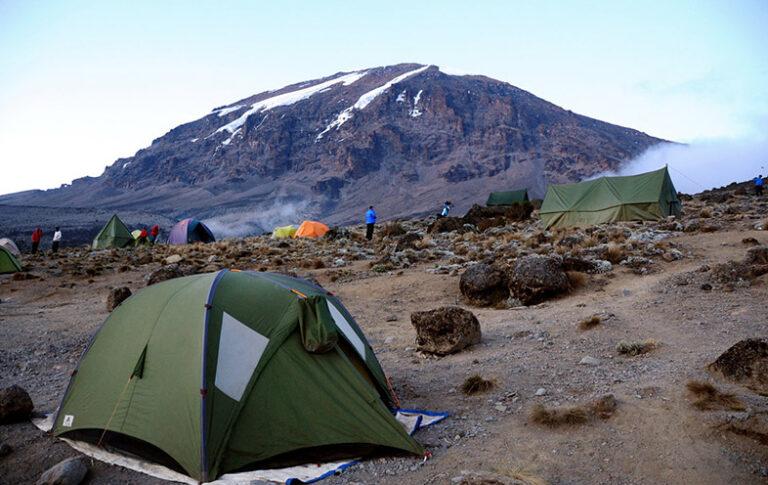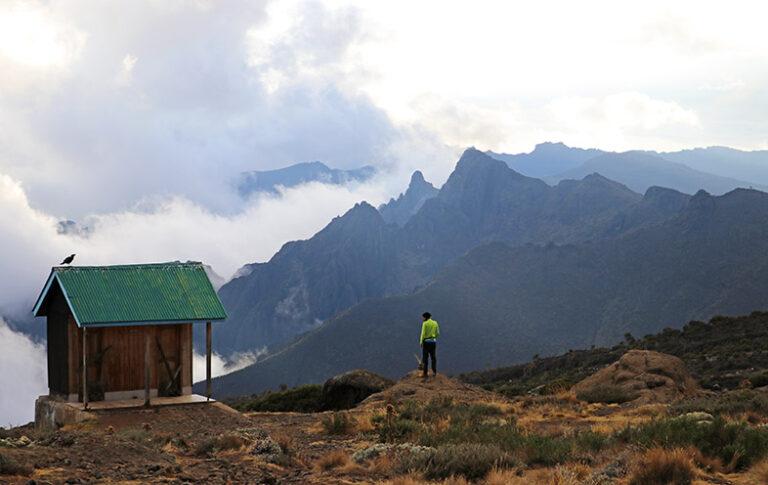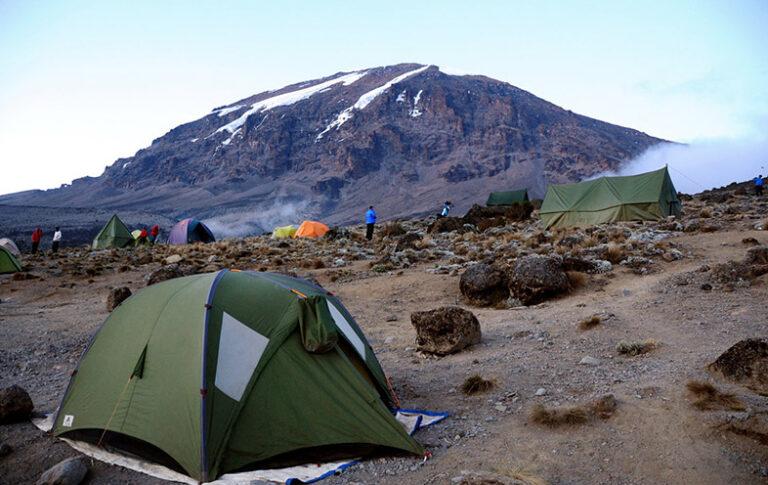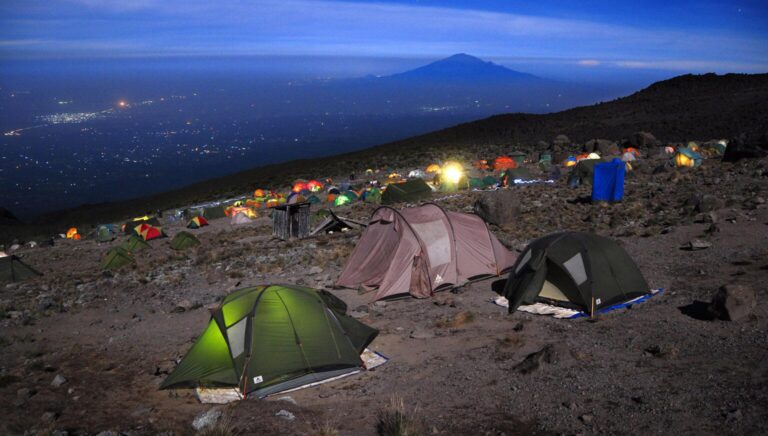Hiking and Trekking in Tanzania
Experience Tanzania’s highest mountains and remotest areas on foot
5 STAR RATED TOUR OPERATOR IN TANZANIA READ OUR REVIEWS ★★★★★
Your hiking and trekking adventure in Tanzania
Trekking is an incredible way to explore the breathtaking mountainous regions of Tanzania, immersing yourself in the beauty of its landscapes and natural wonders.
From scaling towering peaks to hiking through lush forests, Tanzania offers a variety of trekking experiences. Whether it’s volcanoes, plateaus, mountain ranges, lakes, or craters, there are treks of varying lengths and difficulty to suit all adventurers.
Take on Mount Kilimanjaro, Africa’s tallest peak, or trek Mount Meru, a stunning stratovolcano teeming with wildlife. Both mountains boast unique ecosystems, where you’ll encounter remarkable flora and fauna across forests, heathlands, and alpine deserts.



Best Tanzania Trekking & Hiking Trips
FROM CITY HOTELS TO LODGES IN NATURE AND PRIVATE TENTS ON MOUNTAIN TREKS
Day treks are primarily located near the northeastern city of Arusha and the town of Moshi, where you’ll find a selection of hotels, guesthouses, and nature lodges. From these locations, you can participate in a guided walking safari in Arusha National Park for an up-close experience with wildlife. Alternatively, you might enjoy the leisurely-paced trek on the Shira Plateau, which leads to the lowest and oldest peak of Mount Kilimanjaro.
On multi-day mountain treks, you’ll spend the night in shared huts along the Marangu route of Mount Kilimanjaro and Mount Meru. For those opting to climb one of Kilimanjaro’s other three routes, our dedicated mountain teams will set up private two-person tents for you at each campsite before your arrival.

What to expect on Tanzania trekking & hiking trips
Hiking in Tanzania
While Tanzania boasts breathtaking natural landscapes, day hikes may initially seem somewhat limited during a safari. Typically, classic safaris require you to remain in a vehicle for most of your time. However, some national parks and camps do offer bush walks, where you can explore the area around the camp for a few hours with a guide or ranger, immersing yourself in the sounds, smells, and colors of the Tanzanian bush. These walks often focus more on smaller animals and plains game rather than large wildlife, and you’ll likely feel a deep respect for nature from the moment you begin.
When participating in multi-day hikes, you will always be accompanied by a guide or ranger. Supplies such as food, water, and gear are typically transported by donkeys. Unlike in Europe or Southern Africa, it’s uncommon for foreign visitors to hike unaccompanied. Most hikes occur in protected areas, which require a conservation fee. This, along with the costs for rangers and crew, can make multi-day hikes more expensive than you might anticipate. However, we believe the experience will greatly exceed your expectations.
Trekking in Tanzania
If you’re planning to climb Mount Kilimanjaro or Mount Meru, it’s essential to have a mountain guide with you. We have dedicated teams on both mountains, so we can provide you with a guide, porters, a cook, and all the necessary equipment. Our teams will ensure you reach the summit and safely return back down.
Tanzania features a variety of enjoyable hikes and treks. Here are some regional highlights.
Where to go hiking in Tanzania?
The Northern Circuit
Immerse yourself in the African wilderness and create unforgettable memories with a unique guided walking safari in Arusha National Park or Tarangire National Park.
If you’re staying overnight at the rim of the Ngorongoro Crater, we recommend a short walk to the viewpoint for stunning views of the world’s largest caldera.
For those with limited time, consider the Shira Plateau Hike — a one-day trek in Kilimanjaro National Park. Our transfer driver will take you through the park, and your hike will begin at 3,500m. You’ll trek across the Shira Plateau to reach Shira Crater, where you’ll be rewarded with panoramic views of Kibo Peak and the landscapes of both Tanzania and Kenya.
For the adventurous, summiting Mount Kilimanjaro or Mount Meru is a truly remarkable experience. Mount Meru, in particular, is a hidden gem offering stunning scenery and the opportunity to hike through diverse landscapes teeming with African wildlife. With fewer trekkers and a four-day route, Meru is perfect for those looking to follow up their climb with a safari or beach getaway.
Even if summiting isn’t your goal, Tanzania is a hiker’s paradise. On a three-to-five-day trek through the Ngorongoro Conservation Area to Lake Natron, you’ll experience the rich culture and way of life of the Maasai people.
Other mountains in northern Tanzania include Mt. Lomalasin (3,648 m), Mt. Hanang (3,417 m), Ol Doinyo Lengai (2,878 m), and Mt. Longido (2,637 m). In the northeastern Usambara Mountains, you can enjoy breathtaking viewpoints and multi-day hiking adventures.
The Southern Circuit
In southern Tanzania, you can hike through pristine natural areas rich in endemic flora and fauna.
Ruaha National Park and Nyerere National Park (formerly Selous Game Reserve) are among Africa’s last great wildernesses. Here, you can encounter a unique mix of East and Southern African wildlife and plant species, making for a diverse and unforgettable guided walking safari or bush walk.
Udzungwa Mountains National Park hosts 30-40% of Tanzania’s plant species, along with two endangered primate species: the Iringa Red Colobus and the Sanje Crested Mangabey. Access to the park is only on foot, providing a serene experience in nature. It serves as an ideal stop on the Southern Circuit. You can begin your journey in Mikumi National Park, then travel to Udzungwa Mountains National Park to trek to the mountain’s peak or visit Sanje Waterfall, before continuing your safari to other southern parks.
The Western Circuit
The western parks of Tanzania are often untouched wildernesses that provide world-class nature experiences.
Wildlife enthusiasts will be captivated by Katavi National Park, which is not only vast but also seldom visited. Here, you can partake in guided walks and witness large populations of both predators and prey.
Mountain treks in western Tanzania offer a captivating and unique experience. Along the shores of Lake Tanganyika, forested mountains rise above the lake’s pristine white beaches, creating a paradise-like setting. This region is home to two remarkable national parks—Mahale Mountains National Park and Gombe Stream National Park—both featuring luxurious accommodations. Reaching these parks involves a short flight followed by a boat ride, adding an adventurous touch to your journey. Both parks are rich in unique birds and primates and can only be explored on foot, providing exceptional hiking opportunities.
In Gombe Stream National Park, you have the chance to encounter a specific troop of chimpanzees. Thanks to years of study by researchers like Jane Goodall, these chimpanzees are accustomed to human presence, allowing you to come face-to-face with our closest living relatives. While visiting, be sure to check out the small village of Ujiji, where Stanley famously found Dr. Livingstone in 1871.
Where can you go mountain climbing in Tanzania?
Climbing Kilimanjaro
Undoubtedly, Mount Kilimanjaro is Tanzania’s most famous mountain and the tallest in Africa, standing at 5,895 meters. There are six official routes to the summit, with trekking durations ranging from six to nine days, including an optional acclimatization day. Our Kilimanjaro trekking tours specialize in four main routes: Marangu, Machame, Lemosho, and Rongai.
Reaching the summit of Mount Kilimanjaro is a challenge, but you don’t need to be an experienced mountaineer to succeed. All that’s required is the fitness and determination to reach the top. Our dedicated mountain team, who have ascended the mountain hundreds of times, will support and assist you every step of the way, ensuring your safety throughout the journey. After achieving the summit, they will guide you safely back down.
Whether you choose a private trek with your companions or opt for a scheduled group trek with up to ten fellow adventurers, the experience will be unforgettable. You can select the Marangu route for dormitory-style accommodations or one of the other three routes to enjoy the privacy of two-person tents. The summit awaits you—are you ready to take on the challenge?
Climbing Mt Meru
Mount Meru, situated within Arusha National Park, may not be as well-known as Mount Kilimanjaro, but it is equally captivating. Rising to a height of 4,566 meters and located just 80 kilometers from Kilimanjaro, Mount Meru’s slopes provide natural habitats for various wildlife, including elephants, buffaloes, giraffes, baboons, colobus monkeys, and antelopes, creating a breathtaking trekking experience.
The journey to the summit of Mount Meru presents an exhilarating challenge. The Momella route, a four-day trek, takes you through lush forests teeming with wildlife and showcases natural attractions like the hollow fig tree and Malo Falls. As you ascend, you’ll encounter heathland and alpine desert zones, featuring unique vegetation and stunning views of the national park. Even beginner trekkers can navigate the few climbing sections in the final stretch. Traversing the horse-shaped crater rim offers panoramic views of the Ash Cone and the nearby Mount Kilimanjaro.
To reach the summit, determination and good physical condition are essential. Fortunately, our dedicated team of mountain professionals, including a guide, porters, and a cook, will assist you throughout the journey. Climbing Mount Meru promises an unforgettable adventure set against the backdrop of breathtaking African landscapes.
Interested in Guided Safaris?
Have a look at our guided tours, if you want to get to know Tanzania’s wildlife together with a local guide.
Hiking and Trekking in Tanzania Faq
Tanzania is home to several stunning mountains. The most popular are Mount Kilimanjaro (Africa’s highest peak), Mount Meru in Arusha National Park, and lesser-known mountains such as Ol Doinyo Lengai, Mount Hanang, and the Usambara Mountains.
No, you don’t need to be an experienced hiker, but you do need to be physically fit and prepared for the challenge. Both mountains offer routes suitable for beginners, and you’ll be supported by experienced guides and porters throughout the trek.
The best time for hiking and trekking in Tanzania is during the dry seasons, which are from June to October and from December to February. These months offer clear skies and pleasant trekking conditions.
Depending on the route, climbing Mount Kilimanjaro typically takes between 6 to 9 days. Popular routes like Machame, Marangu, Lemosho, and Rongai have varying durations, with some offering an extra day for acclimatization.
Essential trekking gear includes sturdy hiking boots, warm clothing (as temperatures drop at higher altitudes), a rain jacket, a sleeping bag, sunscreen, sunglasses, and a daypack. Your trekking company will typically provide tents, food, and additional equipment.
Yes, altitude sickness can be a concern, especially on Mount Kilimanjaro and Mount Meru. To minimize the risk, it’s essential to acclimatize properly, stay hydrated, and choose a route that allows for a gradual ascent.
Yes, it is mandatory to have a licensed guide for trekking on Mount Kilimanjaro and Mount Meru. Additionally, most treks in national parks and conservation areas require guides for safety and to ensure the conservation rules are followed.
Yes, there are several multi-day treks in Tanzania beyond Kilimanjaro and Meru. Popular options include the Ngorongoro Crater to Lake Natron trek, hikes in the Usambara Mountains, and exploring the lesser-known peaks like Mount Hanang.
Depending on the location, you may encounter a variety of wildlife such as elephants, buffaloes, giraffes, colobus monkeys, and antelopes. Mount Meru, in particular, is known for its rich wildlife on the lower slopes.
The cost of trekking in Tanzania varies depending on the mountain and the services included. Climbing Mount Kilimanjaro or Mount Meru typically costs between $1,500 to $3,000, including guides, porters, permits, and equipment. Shorter or less famous treks can be more affordable.
